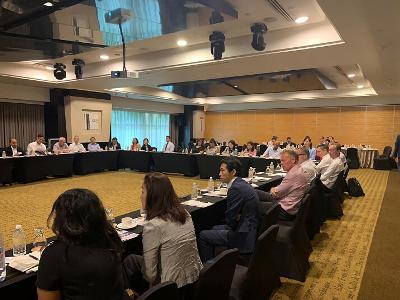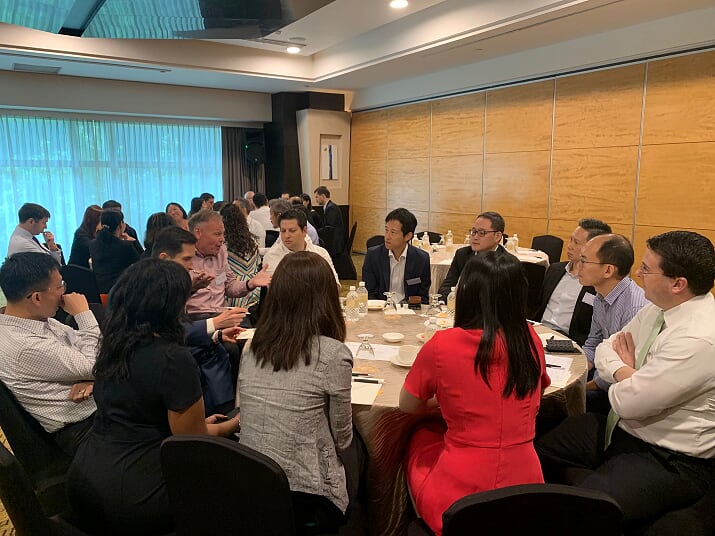 The sixth FP&A Board Meeting was held in Singapore on 9th July 2019. The event brought together over 40 Financial Planning and Analytics specialists to discuss some of the biggest trends in the industry.
The sixth FP&A Board Meeting was held in Singapore on 9th July 2019. The event brought together over 40 Financial Planning and Analytics specialists to discuss some of the biggest trends in the industry.
This week’s meeting focused on Rolling Forecasts and 7 factors for businesses to implement them successfully. The meeting began with a general introduction in which the participants shared their own personal experiences with Rolling Forecasts (RFC). The results of the introduction are summarized below:
| 10% | |
| Implemented with many challenges | 20% | |
| Limited to no practical experience | 70% |
The outcome of this week’s roundtable showed that, despite its many benefits, many companies around the world still aren’t implementing Rolling Forecasts or are struggling to do so effectively. Only a limited number of companies have managed to implement Rolling Forecasts properly and therefore reap the full extent of their benefits.
Key Factors For Successfully Implementing Rolling Forecasts
Following the introduction, the group discussed various definitions of Rolling Forecasts and identified some of the key factors for their successful implementation. The outcomes of this exercise were well-aligned with a summary from previous FP&A Board Meetings which were presented to the group after the discussion and are summarized below:
Culture – Companies need to understand that the Rolling Forecast is not a measurement tool for bonuses. It is more a management tool to identify key risks and opportunities early enough and to better manage the bottom line of the business.
People – Businesses need to assess the skill set of their existing employees because the implementation of Rolling Forecasts requires project teams with the ability to fulfill different roles including analytics, model builders, business partners, and communicators/presenters.
Systems – Organisations need to build a trusted information hub which includes operational and financial insights on which to base their Rolling Forecast model. Furthermore, the system needs to be capable of executing and live modeling big data.
Processes – It’s important to have a management buy-in process that is clearly explained through the whole organization. Regular meetings with full transparency regarding drivers and key estimates help to build trust and increase acceptance of the Rolling Forecast model.
Design – The design phase covers the model itself, including the horizon and frequency of the Rolling Forecast. All of this is driven by the industry, its key market, and business drivers.
Integration – The system needs to be capable of integrating Bottom Up and Top Down planning methods in one application and show transparent deviations of both outcomes.
Participation – The successful implementation of Rolling Forecasts is based on a collaborative approach that involves people from both financial and operational backgrounds, full transparency (regarding drivers and estimates), and a dedicated application on which all of the people involved can work together.
A Case Study from Cindy Lee
This week’s board meeting also featured an inspiring case study presented by Cindy Lee, CFO/COO from Sintellisys. Ms. Lee shared her experienced implementing Rolling Forecasts at Danone, who decided to adopt Beyond Budget processes roughly 3 years ago in order to meet its mission of “sustainable profitable growth”.
The key findings from Ms. Lee’s presentation are summarized below:
Larysa’s Rolling Forecast Maturity Model
Following Ms. Lee’s presentation, Larysa Melnychuk also shared it’s 3-stage Rolling Forecast Maturity Model which she developed during the London FP&A Board Meetings:
Group Work
Following these presentations, the meeting’s participants partook in group workshops where they worked on the following questions:
Analytical Aspect of the Rolling Forecast: What is needed for the leading process?
Full transparency about KPIs and the business’ key drivers are an important enabler for the analytical aspect of the Rolling Forecast. The relevant information needs to be stored in a central trusted data hub and should include financial, operational and external market/competitor information. Many organizations focus too much on financial information and miss important drivers which should be an integral part of the Rolling Forecast model.
Human and Cultural Aspect of the Rolling Forecast: What is needed for the leading process?
The move to a Rolling Forecast approach is a big change for many organizations. The relevant people need to be involved early and the project team needs to be empowered by management. People from both financial and operational roles also need to collaborate on the project, and the organization should be made aware that the Rolling Forecast is a management tool, not just a tool for managing bonuses.

Apliqo’s Experience with Customers: A Practical Way To Implement Rolling Forecasts
To conclude the meeting, Apliqo shared its experience and tips on practical ways for businesses to implements Rolling Forecasts:
Proactive Communication (advertise) – Each company should evaluate the added value of Rolling Forecasts for their organization and, following the buy-in from management, the project team needs to proactively communicate and advertise the concept.
As-Is of Current Plans (document) – The project team needs to review all existing planning layers and document them. Many organizations/departments have planning models with important information for the Rolling Forecast, but these models are often found outside of an existing central planning application.
Analytical Layer (identify drivers) – A Rolling Forecast model starts with the identification of the key drivers of a business. The basis for this is an analytical layer which contains the companies financial and operational information. During this process, the project team should use techniques like Pareto (80/20) to only focus on the most important parts of the business. For example, it doesn`t make sense to forecast all SKUs or customers in a Rolling Forecast. Instead, the forecast should only focus on the key elements that make up roughly 80% of the companies business.
Design Model/Architecture – Once the analytical part of the process is over, the project team needs to build/design the architecture for the company’s Rolling Forecast Model. This model needs to be fully transparent and clearly documented.
Link Operational And Financial Plans – Financials are only the outcome of operational drivers or processes. Without the links between operational and financial plans, organizations struggle to identify root cause/effects and simulate different rolling scenarios.
Use FP&A Best Practice Methods – A Rolling Forecast will not be successful if companies don’t also follow FP&A best practices like driver-based planning, scenario modeling, or integrated planning. It is impossible to execute monthly or quarterly Rolling Forecasts in Excel or other systems just with basic planning techniques like data entry.
Define Frequency And Horizon – Frequency and horizon are mainly driven by an industry’s lead cycle and vary from monthly to quarterly (frequency) and rolling from 2 to 6 quarters (horizon).
Execute And Review Collaborative Plans – The execution of each Rolling Forecast is based on the aforementioned parameters. For a successful implementation of these forecasts, full transparency during the review process is extremely important. The review needs to be based on a clear overview of the outcomes and key assumptions and should be easy-to-understand for those members of the organization that are not in finance. During review meetings, the project team should be able to change key assumptions or drivers and immediately see the outcomes and impacts on the business’ bottom line.
This week’s FP&A Board meeting was hosted by Larysa Melnychuk and sponsored by the FP&A Board partners Apliqo and Michael Page.
The entire team at Apliqo is looking forward to our other upcoming events in 2019.
The next FP&A Board Meeting will take in Brisbane and is about the Global Trends in Financial Planning and Analysis.









